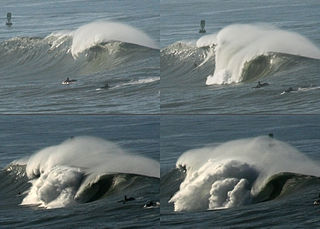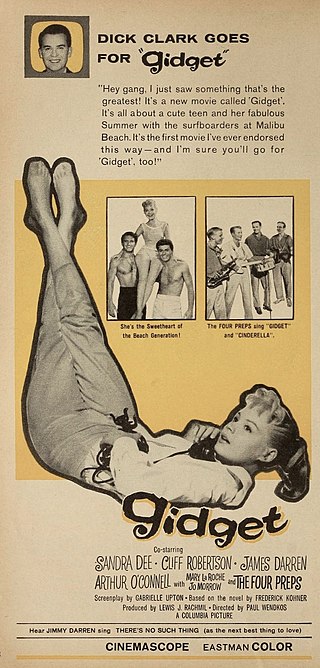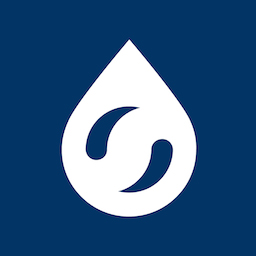Related Research Articles

Surfing is a surface water sport in which an individual, a surfer, uses a board to ride on the forward section, or face, of a moving wave of water, which usually carries the surfer towards the shore. Waves suitable for surfing are primarily found on ocean shores, but can also be found as standing waves in the open ocean, in lakes, in rivers in the form of a tidal bore, or in wave pools.

Bethany Meilani Hamilton is an American professional surfer and writer. In 2003, she survived a shark attack in which her left arm was bitten off; ultimately, she returned to professional surfing and wrote about her experiences in the 2004 autobiography, Soul Surfer: A True Story of Faith, Family, and Fighting to Get Back on the Board. The book was adapted into the 2011 feature film, Soul Surfer. Hamilton attributes her strength to her Christian faith.

Robert Kelly Slater is an American professional surfer, best known for being crowned World Surf League champion a record 11 times. Slater is widely regarded as the greatest professional surfer of all time, and holds 56 Championship Tour victories. He won the Laureus World Action Sportsperson of the Year four-times. Slater is also the oldest surfer still active on the World Surf League, winning his 8th Billabong Pipeline Masters title at age 49.

Bells Beach is a coastal locality of Victoria, Australia in Surf Coast Shire and a renowned surf beach, located 100 km south-west of Melbourne, on the Great Ocean Road near the towns of Torquay and Jan Juc.

Mavericks is a surfing location in northern California outside Pillar Point Harbor, just north of the town of Half Moon Bay at the village of Princeton-by-the-Sea. After a strong winter storm in the northern Pacific Ocean, waves can routinely crest at over 25 ft (8 m) and top out at over 60 ft (18 m). Routinely, waves that break can be recorded on seismometers. The break is caused by an unusually shaped underwater rock formation.

Laird John Hamilton is an American big-wave surfer, co-inventor of tow-in surfing, and an occasional fashion and action-sports model and actor. He is married to Gabrielle Reece, a former professional volleyball player, television personality, and model.
Greg Noll was an American pioneer of big wave surfing and a prominent longboard shaper. Nicknamed "Da Bull" by Phil Edwards in reference to his physique and way of charging down the face of a wave, he was on the U.S. lifeguard team that introduced Malibu boards to Australia around the time of the 1956 Summer Olympics in Melbourne. He produced a "legendary" series of five Search for Surf films.

Surf movies fall into three distinct genres:

Ocean Pacific Apparel Corp. is a clothing company based in Irvine, California, United States. It produces T-shirts, sweatshirts, hoodies, shoes and beverage mugs.

Surf culture includes the people, language, fashion, and lifestyle surrounding the sport of surfing. The history of surfing began with the ancient Polynesians. That initial culture directly influenced modern surfing, which began to flourish and evolve in the early 20th century, with its popularity peaking during the 1950s and 1960s. It has affected music, fashion, literature, film, art, and youth jargon in popular culture. The number of surfers throughout the world continues to increase as the culture spreads.
Ross Clarke-Jones is an Australian big wave surfer. He originally came from Terrigal in the Central Coast, of New South Wales, Australia where he enjoyed surfing Terrigal Haven, a point break that produces rare waves lasting for up to 300 metres on a big swell.

Peʻahi is a place on the north shore of the island of Maui in the U.S. state of Hawaii. It has lent its name to a big wave surfing break, also known as Jaws.

The riding of waves has likely existed since humans began swimming in the ocean. In this sense, bodysurfing is the oldest type of wave-catching. Undoubtedly ancient sailors learned how to ride wave energy on many styles of early boats. Archaeological evidence even suggests that ancient cultures of Peru surfed on reed watercraft for fishing and recreation up to five thousand years ago. However, standing up on what is now called a surfboard is a relatively recent innovation developed by the Polynesians. The influences for modern surfing can be directly traced to the surfers of pre-contact Hawaii.

Lake surfing is surfing on any lake with sufficient surface area for wind to produce waves. As with ocean surfing, ideal wave conditions are when the wind switches offshore. However, when this occurs over a lake the waves generated by previous onshore wind subside relatively quickly. This means lake surfers have a shorter window of opportunity to surf ideal waves. Lake surfers are often out during and experiencing the same storm that creates the waves whereas ocean surfers are more often surfing on swell produced by storms hundreds of miles away and that may have taken days to reach shore. In addition to making it more difficult to manage surfboards, high winds can make the face of a wave and water surface rough. Increased wave frequency due to shorter fetch results in less rest between waves and sets of waves. This can make it necessary to paddle out through waves because there may not be a long enough pause between sets to paddle out between them.
International Surfing Day, held annually on the third Saturday of June, is an unofficial, environmentally conscious sports-centered holiday that celebrates the sport of surfing, surfing lifestyle, and the sustainability of ocean resources. Contests and prizes are also part of the celebration, with surfing-related industries donating prizes such as surfboards and wetsuits. Another purpose of the celebration is to promote the popularity of surfing and to attract new participants.
Colin Patrick "Col" McPhillips is an American professional longboard surfrider and three times ASP Longboard World Champion.
Out of Place is a surfing documentary directed by Scott Ditzenberger and Darrin McDonald that follows the lives of several lake surfers in Cleveland, Ohio. While Lake Erie does not offer the quality of waves they would prefer, business commitments, family, and friends keep them from moving. As the best waves occur in the winter, the surfers often experience freezing conditions including during a snowbound Great Lakes Eastern Surfing Association competition featured in the film.

The North Shore, in the context of geography of the Island of Oʻahu, refers to the north-facing coastal area of Oʻahu between Kaʻena Point and Kahuku. The largest settlement is Haleʻiwa.

Surfline is a company and website based in Huntington Beach, California that specializes in surf forecasting and surf reports, live webcasting, photography, videography, as well as editorial coverage of the sport of surfing. Surfline.com is now ranked 1,180 in the US and 5,784 in the world in terms of popularity compared to other websites and is now the largest provider of streaming HD coastal cams. Since 2003 it has taken on buoyweather.com and fishtrack.com (2012), on average the family of websites receives 175,000 visitors per day. The site includes streaming video, surf reports and forecasts. Surfline.com offers over 500 streaming cameras at 150 surf breaks, and is one of the larger surf cam websites. Surfline currently has approximately 50 employees.
John Severson was an American editor, author, filmmaker and artist, widely known as the founder of Surfer, a magazine focused on the sport and culture of surfing. Severson also created a diverse body of artwork dedicated to the sport.
References
- 1 2 Pritchard, James (4 June 2005). "Surfin' USA Great Lakes Style". Ludington Daily News . Associated Press. Retrieved 16 November 2013.
- 1 2 Minicucci, Daniela (21 June 2005). "It's safe to surf this beach!; New documentary reveals the cult of freshwater surfing that revolves around the Great Lakes". Toronto Star . Retrieved 15 November 2013.
- ↑ "Grand Haven videographer prepares new documentary on water quality". MLIve.com. 22 December 2008. Retrieved 15 November 2013.